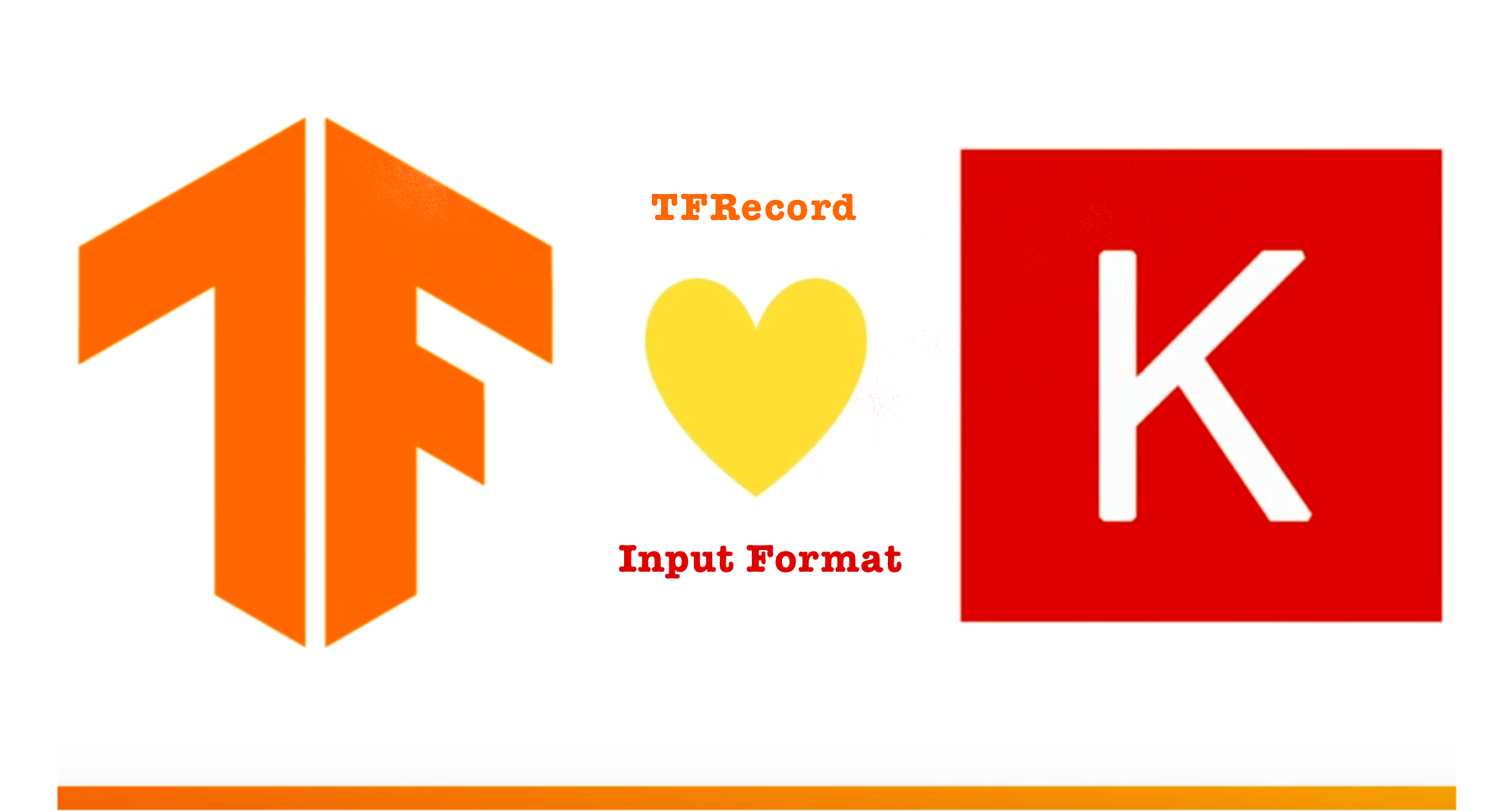TensorFlow 篇 | TensorFlow 数据输入格式之 TFRecord

「导语」 TFRecord 是 TensorFlow 生态中的一个重要组件,它是一种二进制序列的存储格式,使用该格式可以使输入数据的读取和处理更为高效,从而提升整体训练流程的速度,另外,它还具有极高的灵活性,可以为复杂特征数据的构建与解析提供便利。本文将对 TFRecord 数据文件的生成与读取流程进行详细地介绍,并提供相应的示例代码作为参考。
TFRecord 格式简介
TFRecord 是 TensorFlow 生态中一个重要的组件,其本质上是一种文件格式,用于存储二进制序列的内容。 TFRecord 文件由序列化后的 protobuf 数据构成,可以直接供 TensorFlow 程序读取并用于模型训练。
对于文本格式的数据文件而言,其存储和读取的开销都比较大,相比之下, TFRecord 格式的数据文件占用的磁盘空间会更少,而且可以更高效地进行数据读取,因此将数据使用 TFRecord 格式存储能够在一定程度上提升数据处理的效率。
另外,文本格式的数据更适合处理定长且维度单一的特征数据,对于变长以及多维度的特征数据的处理会比较麻烦,而 TFRecord 格式的数据则没有这一限制,这给数据读取与处理带来了极大的灵活性。
TFRecord ProtoBuf
在生成或者读取 TFRecord 文件之前,我们需要对与 TFRecord 格式相关的 protobuf 协议有一定的了解,它们是构成 TFRecord 文件的关键部分。
Example
Example 指一个数据输入样本,它由一系列的特征组成。其 protobuf 格式如下所示:
上面的 Features 即指特征组合,其 protobuf 格式如下所示:
这里 Features 使用 map 结构来进行存储,其中 map 的 key 表示特征的名称,为 string 类型, value 表示具体的特征值,为 Feature 类型。
另外,可以看到 Example 只是封装了一下 Features 的结构,其实质与 Features 是等同的。
Feature
Feature 指具体的特征值,其 protobuf 格式如下所示:
从 Feature 的定义可以看出,它可以接收三种格式的数据,分别为:
BytesList格式,可以表示string或byte类型的数据。
FloatList格式,可以表示float和double类型的数据。
Int64List格式,可以表示bool类型、enum类型、int32类型、uint32类型、int64类型以及uint64等多种类型的数据。
以上三种格式,基本囊括了所有常见的数据输入类型,在生成和解析 TFRecord 数据时,可以根据具体的数据类型来使用相应的 Feature 结构。
Python 实现
在将上述 protobuf 文件转为语言相关的数据结构后,即可使用这些结构来构建特征数据并进行序列化了。下面以 python 语言为例,来介绍这些数据结构的具体使用方法。(注:在 TensorFlow 的 python 安装包里已经包含了 Example 以及 Feature 等相关的数据结构,我们可以直接使用而无需再用 protoc 工具生成了。)
首先,我们需要构建 Feature 对象。因为 Feature 结构支持 3 种格式的数据,所以这里使用 3 个函数来分别生成不同类型的 Feature 对象。示例代码如下所示:
其中 _bytes_feature 、 _float_feature 和 _int64_feature 函数分别用来生成 BytesList 、 FloatList 和 Int64List 格式的 Feature 对象,这里假设这 3 个函数的参数 value 均为单个值。
由于 tf.train.*List 函数接收的参数均为列表 (list) 或数组 (array),所以上面的代码中才会加上 [] 符号来表示列表,如果输入的参数 value 已经为列表或数组则无需此操作。另外还需注意传递给 3 个函数的参数 value 的基础类型要与具体的 *List 相匹配,否则会报错。
在生成了 Feature 对象后,可以调用其 SerializeToString 方法对其进行序列化,从而生成序列化后的字符串。另外还可以使用 tf.train.Feature.FromString 方法来将序列化后的数据还原为 Feature 对象。
接着,我们就可以构建 Example 对象并对其进行序列化了。假设我们有 4 种 Feature ,它们分别为 boolean 类型的特征、 integer 类型的特征、 string 类型的特征和 float 类型的特征,我们首先将这 4 种特征通过上面 3 个函数编码后返回相应的 Feature 对象,然后构建一个 Feature Map 字典并生成 Features 对象,最后使用 Features 对象生成 Example 对象并进行序列化。将上述流程统一到一个函数 serialize_example 中,其示例代码如下所示:
同样地,可以调用 Example 对象的 SerializeToString 来将其序列化为字符串,调用 tf.train.Example.FromString 方法来将序列化后的 Example 对象还原。
TFRecord 文件生成
假设我们有 4 种类型的 Feature ,如上一节所述,并假设它们的原始数据 (numpy) 生成方式如下述代码所示:
现在我们要使用这 4 种 Feature 来生成一个包含 10,000 个数据样本的 TFRecord 文件,可以使用以下几种方式进行生成。
使用 tf.data 生成
首先使用 tf.data.Dataset.from_tensor_slices 函数来生成一个包含原始数据类型的 dateset ,代码如下所示:
接着我们使用上一节定义的 serialize_example 函数来生成一个包含序列化字符串类型的 dataset ,代码如下所示:
最后我们将序列化后的 dataset 写入 TFRecord 文件中,代码如下所示:
注意这里的 writer 使用的是 tf.data.experimental.TFRecordWriter 对象,它专用于将序列化的 dataset 对象写入到 TFRecord 文件中,要与后面介绍的 tf.io.TFRecordWriter 对象区分开来。
使用 tf.io 生成
首先将每个数据样本都转为 tf.train.Example 对象并序列化,然后再将其写入 TFRecord 文件中,这里同样使用上面介绍过的 serialize_example 函数来进行序列化,代码如下所示:
这里的 writer 使用的是 tf.io.TFRecordWriter 对象,它直接将序列化的字符串写入到 TFRecord 文件中。
一般情况下,这种生成 TFRecord 文件的方式在 python 中是最常使用的,在实际使用中可以根据具体情况进行选择。
使用 MapReduce 生成
在数据处理环节,我们可能会使用 MapReduce 进行一些预处理操作,同时我们也希望可以直接借助 MapReduce 任务来生成多个 TFRecord 数据文件以供分布式训练使用,为了满足这一需求, TensorFlow 生态提供了一个扩展库 tensorflow-hadoop ,它包含了 TFRecord 格式的 MapReduce InputFormat 和 OutputFormat 实现。利用这个扩展库,我们就可以直接使用 MapReduce 任务来生成和读取 TFRecord 文件了。部分示例代码如下所示:
需要注意的是,为了匹配正在使用的 hadoop 版本,你可能需要修改 tensorflow-hadoop 源码中的 pom.xml 文件,将 hadoop.version 设置为你正在使用的 hadoop 版本并使用 maven 工具重新编译该项目,然后将生成的 jar 包引入到 MapReduce 项目中,避免因版本不匹配而报错。
另外,为了使 MapReduce 项目能正常编译,你还需引入 org.tensorflow:proto 库以及 com.google.protobuf:protobuf-java 库,可以从 maven 官方仓库搜索这 2 个库的最新版本并加入到 gradle 或 maven 项目的配置文件中,然后再进行项目编译即可。
使用 TFRecorder 生成
由于在生成 TFRecord 文件时往往需要编写大量的复杂代码,为了优化代码的复杂度, TensorFlow 官方开源了 TensorFlow Recorder 项目(即 TFRecorder)来更为便捷地生成 TFRecord 文件。
TFRecorder 允许用户从 Pandas dataframe 或 CSV 直接生成 TFRecords 文件,而无需编写任何复杂的代码。其对于图像数据的处理尤其方便,在 TFRecorder 之前,要大规模生成 TFRecord 格式的图像数据,必须编写一个数据流水线来从存储中加载图像并将结果序列化为 TFRecord 格式,而现在只需几行代码即可生成基于图像的 TFRecord 文件。示例代码如下所示:
更多 TFRecorder 的用法请参考其官方文档。
TFRecord 文件读取
TensorFlow 提供了专用于读取 TFRecord 文件的 API 接口 tf.data.TFRecordDataset ,该接口可以将 TFRecord 文件中的内容读取到 dataset 中。代码如下所示:
此时 dataset 中存储的是序列化格式的字符串,如果要将其解析为真实的值,还需要进一步操作。
还原为 Example
我们可以将 raw_dataset 中的每个元素都还原为 tf.train.Example ,一般在小范围对 TFRecord 数据进行检查时使用,示例代码如下所示:
模型训练使用
为了在模型训练时使用该 dataset ,我们需要将 raw_dataset 中的每个元素都解析为 FeatureMap ,以匹配 Keras 模型的输入与输出。代码如下所示:
这里使用了 tf.io.parse_example 函数来将序列化后字符串解析为指定的数据类型,我们需要提前准备好 feature_description 字典, 该字典定义了 feature 的名称、长度(定长/变长)、数据类型以及默认值,以供在解析时使用。最终我们通过调用 raw_dataset 的 map 方法来将该解析函数应用到 dataset 中的每个元素。
另外,我们也可以使用 tf.io.parse_single_example 函数来进行解析,但要注意它与 tf.io.parse_example 的区别,前者适合解析单个序列化的元素,而后者适用于一个 batch 的解析。在TensorFlow 数据输入的最佳实践一文中曾介绍过 dataset 的向量化 map 操作,即对 dataset 先应用 batch 转换然后再应用 map 转换以提升效率,因此这里推荐使用后者作为序列化数据的解析函数。
最终我们可以将 parsed_dataset 应用于模型的训练中。示例代码如下所示:
注: label 数据需要与 features 数据放在同一个 dataset 中, TensorFlow 会根据模型输入和输出 Tensor 的 name 去 dataset 中获取相应的数据来进行训练。
参考资料
版权声明: 本文为 InfoQ 作者【Alex】的原创文章。
原文链接:【http://xie.infoq.cn/article/70a763d42850678f8acfa38e9】。文章转载请联系作者。












评论